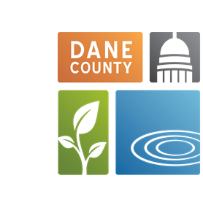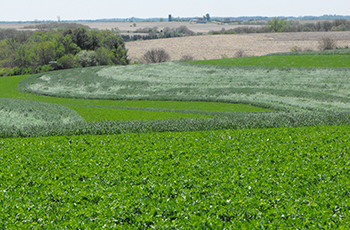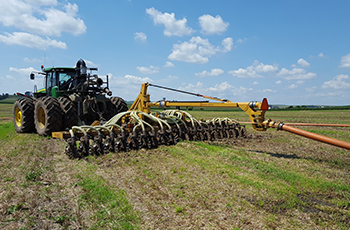
The Land & Water Resources Department supports the use of agricultural conservation practices to produce benefits such as reduced erosion and improved soil and water quality. Listed below are a variety of local, state and federal programs that can help farmers and landowners implement these practices through conservation programs.
Dane County provides cost-share funds for installation of conservation practices to implement Dane County’s Land and Water Resource Management Plan. Funding is part of a grant from the Wisconsin Department of Agriculture, Trade and Consumer Protection (DATCP). Eligible practices fall under the categories of structural and management. Eligible practices can include streambank protection, diversions, terraces, grass waterways, grade stabilization structures, access road (channel crossings), water sediment control structures, clean water for barnyards, and storage facility closure, barnyard runoff control systems and nutrient management. Criteria for evaluating cost-share applications is conducted through the Land Conservation Committee.
 The Continuous Cover Program provides funding to help farmers and landowners maintain a continuous plant cover on agricultural lands. Maintaining continuous cover helps to increase water infiltration, reduce soil erosion, improve water quality, build soil health, enhance wildlife habitat, sequester carbon and diversify production practices. This program allows farmers and landowners to convert land that is currently in an annual crop into a perennial cool-season grass mix, native prairie mix or grazing mix.
The Continuous Cover Program provides funding to help farmers and landowners maintain a continuous plant cover on agricultural lands. Maintaining continuous cover helps to increase water infiltration, reduce soil erosion, improve water quality, build soil health, enhance wildlife habitat, sequester carbon and diversify production practices. This program allows farmers and landowners to convert land that is currently in an annual crop into a perennial cool-season grass mix, native prairie mix or grazing mix.
 In 2008, a partnership called Yahara CLEAN (Capital Lakes Environmental Assessment and Needs) was forged between the City of Madison, Dane County, and the State Departments of Natural Resources (DNR) and Agriculture, Trade and Consumer Protection (DATCP). This effort was bolstered by funding from the agency partners to engage the community and establish clear and achievable goals and an implementation plan for cleaning the lakes, and a grant from the Madison Community Foundation to partner in developing a community vision to guide long-term strategies. The result of this combined effort was broad collaboration and involvement from scientific and technical experts, agency staff, and many local lake organizations, farmers, business leaders, policymakers and concerned individuals.
In 2008, a partnership called Yahara CLEAN (Capital Lakes Environmental Assessment and Needs) was forged between the City of Madison, Dane County, and the State Departments of Natural Resources (DNR) and Agriculture, Trade and Consumer Protection (DATCP). This effort was bolstered by funding from the agency partners to engage the community and establish clear and achievable goals and an implementation plan for cleaning the lakes, and a grant from the Madison Community Foundation to partner in developing a community vision to guide long-term strategies. The result of this combined effort was broad collaboration and involvement from scientific and technical experts, agency staff, and many local lake organizations, farmers, business leaders, policymakers and concerned individuals.
The Yahara CLEAN cost-share program provides cost-share funds to support the implementation of conservation practices and systems that reduce both nutrient and sediment runoff to nearby streams which have the greatest potential for water quality benefits.
 To compliment the conservation practices installed by producers in the Yahara River Watershed, and further reduce phosphorous losses from cropland, the Dane County Land & Water Resources Department developed the Harvestable Grass Buffer Program available to producers in the Yahara River Watershed for land located in Dane County. This program allows producers to establish a perennial grass cover which can be harvested and utilized while maintaining the environmental benefits of grass buffer strips.
To compliment the conservation practices installed by producers in the Yahara River Watershed, and further reduce phosphorous losses from cropland, the Dane County Land & Water Resources Department developed the Harvestable Grass Buffer Program available to producers in the Yahara River Watershed for land located in Dane County. This program allows producers to establish a perennial grass cover which can be harvested and utilized while maintaining the environmental benefits of grass buffer strips.
 To improve water quality within the Yahara River Watershed, the Dane County Land & Water Resources Department in collaboration with Yahara Pride Farms, Clean Lakes Alliance, and Yahara WINs offers a cost-share assistance program to producers for the purchase of Low Disturbance Manure Injection (LDMI) equipment. This program is available to producers who own or operate land located in the Yahara Watershed that are currently either surface applying or incorporating manure. The program is intended to help offset some of the cost for producers to purchase the equipment which allows manure to be applied in a manner that greatly reduces its risk of entering nearby surface waters.
To improve water quality within the Yahara River Watershed, the Dane County Land & Water Resources Department in collaboration with Yahara Pride Farms, Clean Lakes Alliance, and Yahara WINs offers a cost-share assistance program to producers for the purchase of Low Disturbance Manure Injection (LDMI) equipment. This program is available to producers who own or operate land located in the Yahara Watershed that are currently either surface applying or incorporating manure. The program is intended to help offset some of the cost for producers to purchase the equipment which allows manure to be applied in a manner that greatly reduces its risk of entering nearby surface waters.
Factsheet for Haulers Application for Haulers Factsheet for Producers Application for Producers
The primary objective of the Wisconsin Working Lands Initiative is to preserve farmland for future generations. The initiative passed in 2009 and can be found primarily in Chapter 91 of Wisconsin State Statutes. Main components are listed below.
Farmland Preservation Program (FPP)
The purpose of the FPP program is to help preserve farmland through local planning and zoning, and to provide tax credit to participating landowners. Landowners in Agricultural Zoning Districts A-1 Ex, A-4 and A-B (all Towns except for Bristol, Burke, Middleton and Springdale) qualify for the FPP tax credit if they meet the eligibility requirements. Note: Land enrolled in Wisconsin Department of Natural Resources Managed Forest Law is eligible for the tax credit provided that specific requirements are met. Useful links:
Agricultural Enterprise Area (AEA)
An AEA is an area of contiguous land primarily in agricultural use that has been designated by the Department of Agriculture, Trade and Consumer Protection (DATCP) in response to a locally developed petition. It can be used by individuals and communities to meet locally identified agricultural preservation and agricultural development goals. Dane County has three designated AEAs: Town of Dunn, Town of Windsor and Vienna-Dane-Westport. More information about Dane County AEAs, including petition text, rule map and parcel number list, can be found at Farmland Preservation Agricultural Enterprise Areas (DATCP). Eligible landowners in these three designated AEAs, can enter into voluntary farmland preservation agreements to collect the farmland preservation tax credits. Participants can receive a tax credit of $10.00 for each eligible acre. To determine if your parcels are included within the three Dane County AEAs, click on the Interactive Map (DATCP). If your parcels are within a designated AEA, please contact Curt Diehl at the Dane County Land Conservation Division, 608-224-3741, for more information.
Purchase Agriculture Conservation Easements (PACE)
The Working Lands Initiative establishes a new program to provide up to 50% of the cost of purchasing agricultural conservation easements, including transaction costs. Through the Purchase of Agricultural Conservation Easements (PACE) program, the state will provide funding to cooperating local governments or non-profit organizations to purchase easements from willing landowners. Land with an agricultural conservation easement cannot be developed for any purpose that would prevent its use for agriculture. The PACE program is not currently accepting applications. See the Wisconsin Department of Agriculture, Trade and Consumer Protection (DATCP) for more information.
Conservation Reserve Enhancement Program (CREP)
CREP is a subprogram of the Conservation Reserve Program and is administered by both USDA and the state of Wisconsin. Through this program, participating landowners voluntarily establish conservation practices on environmentally sensitive agricultural land. These conservation practices are intended to decrease erosion, restore wildlife habitat, and safeguard ground and surface water, while leaving the majority of the land in agricultural production. USDA pays enrollees annual land rental payments for 15 years, as well as cost-sharing for 50% of the cost of installing conservation practices.
Our department works in partnership with the USDA - Natural Resources Conservation Service and USDA – Farm Service Agency to administer federal conservation programs. More information on program specifics and eligibility requirements can be found on our partners' websites.
Conservation Stewardship Program
The Conservation Stewardship Program (CSP) is geared to agricultural producers already participating in conservation activities who are interested in doing more. Agricultural producers may apply to enter into five-year contracts providing: annual payments for installation of new conservation practices and maintenance of old practices; and supplemental payments for adopting crop rotation systems.
Environmental Quality Incentives Program
The Environmental Quality Incentives Program (EQIP) offers financial assistance and technical help to eligible participants for the installation or implementation of structural and management practices on eligible agricultural land. Program participants enroll in the program under contracts of up to ten years. This program provides funds for addressing resource concerns that may exist on agricultural lands.
Conservation Reserve Program
The Conservation Reserve Program (CRP) encourages private landowners to establish vegetative covers on land susceptible to erosion.
Conservation Reserve Enhancement Program
The Conservation Reserve Enhancement Program (CREP) is a subprogram of the Conservation Reserve Program and is administered by both USDA and the state of Wisconsin. Through this program, participating landowners voluntarily establish conservation practices on environmentally sensitive agricultural land. These conservation practices are intended to decrease erosion, restore wildlife habitat, and safeguard ground and surface water, while leaving the majority of the land in agricultural production. USDA pays enrollees annual land rental payments for 15 years, as well as cost-sharing for 50% of the cost of installing conservation practices.